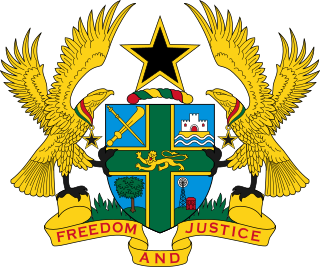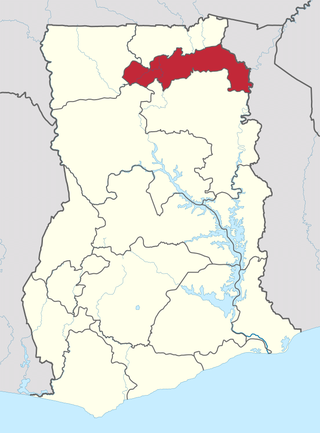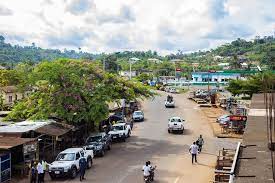
The regions of Ghana are the first level of subnational government administration within the Republic of Ghana. As of 2020, there are 16 regions, which are further divided for administrative purposes into 260 local metropolitan, municipal and district assemblies.

Osei Tutu II is the 16th Asantehene, enstooled on 26 April 1999. By name, Otumfuo Osei Tutu II is in direct succession to the 17th-century founder of the Ashanti Empire, Otumfuo Osei Tutu I. He is also the Chancellor of the Kwame Nkrumah University of Science and Technology. Otumfuo Osei Tutu II is the Grand Patron of the Grand Lodge of Ghana and the Sword Bearer of the United Grand Lodge of England.

The Districts of Ghana are second-level administrative subdivisions of Ghana, below the level of region. There are currently 261 local metropolitan, municipal and district assemblies.

The Upper West Region of Ghana is located in the north-western corner of Ghana and is bordered by Upper East Region to the east, Northern Region to the south, and Burkina Faso to the west and north. The Upper West regional capital and largest settlement is Wa. The Upper West was created by the then Head of State, Flight-Lieutenant Jerry Rawlings in 1983 under the Provisional National Defense Council (PNDC) military regime. The area was carved out of the former Upper Region, which is now the Upper East Region. For about thirty-five years, it remained the youngest region of Ghana until 2018 when six more regions were created by the Nana Addo Dankwa Akufo-Addo government; hence increasing the total number of administrative regions in the country to sixteen.

Bawku is a town and is the capital of the Bawku Municipal District, district in the Upper East region of north Ghana, adjacent to the border with Burkina Faso. It is located approximately between latitudes 11o 111 and 100 401 North and longitude 0o 181w and 0o 61 E in the north-eastern corner of the region. The municipality has a total land area of about 257 sq km. The Municipality was established by Legislative Instrument (L.I) 2103. The municipality has a total land area of about 257 sq km. Bawku has a 2021 settlement population of 119,458 people. Hon. Ayariga Mahama is the Member of Parliament for Bawku Central Constituency.
Ejisu is a city in Greater Kumasi located along the Kumasi-Accra highway about 20 km from Kumasi. It is the capital of Ejisu Municipal Assembly, a municipality of the Ashanti Region, Ghana. This municipal is one of the 30 administrative and political Districts in the Ashanti Region of Ghana and it was established by Legislative Instrument (L.I) 1890. In 2020, the Nkosuohene of Ejisu was Nana Kofi Poku. In 2022, the Chief of Ejisu was Nana Afrane Okese. As at 2024. the Municipal Chief Executive of the town was Mr Samuel Oduro Frimpong.
In several Akan nations of Ghana, the Omanhene is the title of the supreme traditional ruler ('king') in a region or a larger town. The omanhene is the central figure and institution of the nation. Officially, he has no function in the current Ghanaian political setup, but, has enormous influence on the people that constitute it. Today 'Hene' can be found in titles of other rulers in Ghanaian nations. For example, the chief of the Dagomba in the north of Ghana is known as the 'Dagombahene'.
The Sefwi are an Akan people.
Asunafo North Municipal District is one of the six districts in Ahafo Region, Ghana. It was formerly part of the then-larger Asunafo District from 1988 until the southern part of the district was split off by a decree of president John Agyekum Kufuor on 12 November 2003 to become Asunafo South District. The remaining northern part was renamed as Asunafo North District which was later elevated to municipal status on 29 February 2008 to become Asunafo North Municipal District. The municipality is located in the western part of Ahafo Region and has Goaso as its capital town.
Kwawkrom is a community in the Bibiani-Anhwiaso-Bekwai Western Region of Ghana. It is a rain forest reserve situated near the Boin Tano Nature Reserve. It is approximately 20 kilometers South West of Bibiani.

Kwaku Afriyie is a Ghanaian politician, farmer and a member of the New Patriotic Party in Ghana. He was the Western Regional minister of Ghana from 2017 to 2018. He was appointed by President Nana Addo Danquah Akuffo-Addo in January 2017 and was approved by the Members of Parliament in February 2017. He is the member of Parliament for Sefwi Wiawso constituency in the Western North Region of Ghana in 7th and Eighth Parliament of the Fourth Republic of Ghana.
The Sefwi Wiawso Senior High School is co-ed second cycle educational institution in Sefwi Wiaso in the Western North Region of Ghana.

Juaboso District is one of the nine districts in Western North Region, Ghana. Originally it was formerly part of the then-larger Juaboso-Bodi District in August 2004, which was created from the former Sefwi-Bibiani District Council, until the southeast part of the district was split off to create Bodi District on 28 June 2012; thus the remaining part has been renamed as Juaboso District. The district assembly is located in the northwest part of Western North Region and has Juaboso as its capital town.

The North East Region is one of the sixteen regions of Ghana. It is located in the north of the country and was created in December 2018 after a referendum was voted upon to break it off of the Northern region. The region's capital is Nalerigu.
Okogyeabour Nkuah Okomdom II was a traditional ruler and Paramount chief of the Sefwi Wiawso Traditional Area in the Western Region of Ghana from 1997 to 2011.
Alluolue Festival is a Ghanaian annual festival celebrated by the chiefs and people of Sefwi Wiawso and Sefwi Bekwai in the Western North region, formally Western region of Ghana. It is usually celebrated in the month of July. Others also claim it is celebrated in November/December.
Sefwi Debiso is a town in the Bia West District in the Western North Region of Ghana. It is a central town located between three major towns: Essam, Sefwi Adabokrom and Adwuofua. Because of rapid expansion, Debiso has conurbated with the nearby Community Essam. Presently, Sefwi Debiso & Essam serve as co-capitals of the Bia West District. There are direct distant routes from Debiso to major towns such as Kumasi, Berekum, Mim Ahafo, Sefwi-Wiawso and republic of Ivory Coast. Debiso is known for producing cocoa and timber. Debiso is also noted for the Bia National Park.
Adabokrom is a town in Western North Region of Ghana. It is the capital of Bia East. Adabokrom was named the District capital after Bia East District split from Bia District in 2012. Adabokrom is about 250 km west of Kumasi. The town is noted for cocoa production.
Sefwi Bodi is a town in the Western North Region of Ghana. The people in this community are mainly Sefwi people. In June 2012, Sefwi Bodi wa elevated as the capital of the then newly created Bodi (district). Bodi is 60 km west of Sefwi Wiawso the regional capital. Bodi is considered one of the breadbaskets of Ghana. Greater percentage of foodstuffs sent to major cities like Kumasi and Accra come from Sefwi Bodi. Sefwi Bodi is noted for the Bodi Senior High School which is the only second cycle institution in that area of the country.
HRH Oheneba Nana Kwame Obeng II is the recognized traditional sovereign leader of the Sefwi Obeng-Mim stool lands and Chief of the Royal House of Sefwi Obeng-Mim in the Republic of Ghana. He is the ruler, and Toufohene of the dynastic orders, of Sefwi Obeng-Mim stool lands, a subnational kingdom in the Sefwi Wiawso Traditional Territory of Ghana. He was appointed by the Paramount Chief as a Divisional Chief, overseeing other local chieftaincies.

























